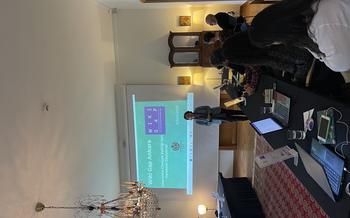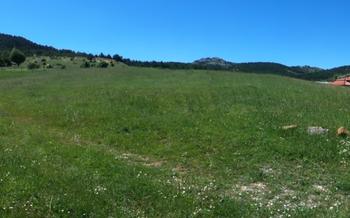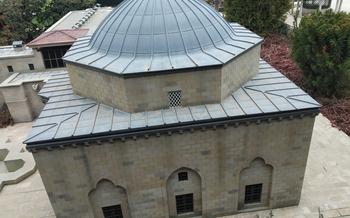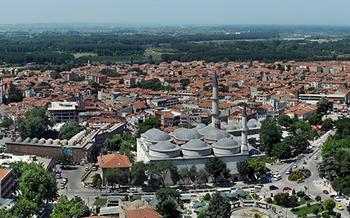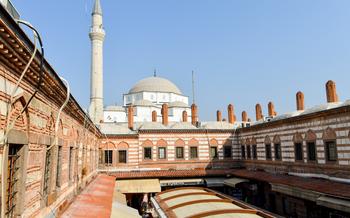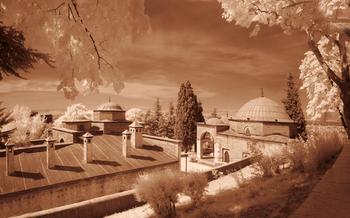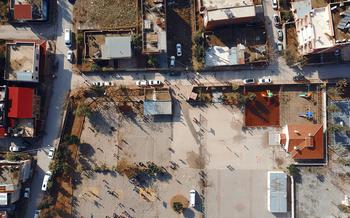
Göğceli Mosque
- Historical Significance
- Architectural Marvel
- Religious Importance
- Cultural Symbol
- Visitor Experience
- Prayer Hall
- Interior Design
- Historical Context
- Local Significance
- Guided Tours: Unveiling the Mosque's Rich History
- Photography Opportunities
- Educational Programs
- Dress Code: Respecting Cultural Norms
- Cultural Etiquette
- Insider Tip:
Historical Significance
The Göğceli Mosque stands as a testament to the rich history and cultural significance of Samsun. Built in the 16th century during the Ottoman era, the mosque has witnessed centuries of change and development in the city. It is considered one of the oldest and most prominent landmarks in Samsun, reflecting the city's deep-rooted Islamic heritage.
The mosque's unique architectural features set it apart from other religious structures in the region. Its distinctive minaret, rising high above the cityscape, serves as a beacon of faith and a symbol of Islamic architecture. The intricate details and craftsmanship of the mosque's exterior and interior reflect the skill and artistry of the Ottoman builders.
Architectural Marvel
The Göğceli Mosque stands as a testament to the harmonious blend of Islamic and Ottoman architectural styles. Its exterior boasts intricate carvings and tilework that showcase the craftsmanship and artistry of its builders. The main entrance features a stunning arched doorway adorned with delicate patterns and calligraphy, inviting visitors into a world of spiritual tranquility. The mosque's minaret, a symbol of guidance and devotion, rises majestically above the cityscape, providing breathtaking panoramic views of Samsun. The dome, a symbol of heaven and unity, is adorned with intricate designs and patterns that reflect the mosque's rich cultural heritage. The combination of these architectural elements creates a awe-inspiring sight that leaves visitors in awe of its beauty and grandeur.
Religious Importance
The Göğceli Mosque holds immense religious significance for Muslims in Samsun and beyond. As a prominent place of worship, it serves as a spiritual and communal hub for the local Muslim population. The mosque's grand architecture and serene atmosphere create an ideal environment for prayer, reflection, and religious gatherings.
During the holy month of Ramadan, the mosque hosts special prayers and recitals of the Quran, attracting a large number of devotees. The mosque also plays a crucial role in celebrating religious festivals like Eid al-Fitr and Eid al-Adha, bringing together the community for joyous celebrations and festivities.
Beyond its role as a place of worship, the Göğceli Mosque also serves as a center for Islamic education and learning. It offers classes and workshops on various aspects of Islam, providing a platform for individuals to deepen their understanding of the religion and its teachings. The mosque's religious significance extends beyond the local community, attracting visitors from across the region who seek spiritual enlightenment and guidance.
Cultural Symbol
The Göğceli Mosque stands as a proud symbol of Turkish culture and heritage, deeply embedded in the tapestry of Samsun's identity. It serves as a testament to the city's rich history, showcasing the fusion of Islamic and Ottoman architectural styles. The mosque's unique design and intricate details reflect the artistry and craftsmanship of its builders, embodying the essence of Turkish cultural heritage.
Moreover, the Göğceli Mosque plays a vital role in preserving and showcasing Turkish traditions. It serves as a venue for religious festivals and celebrations, bringing the community together to celebrate their shared faith and customs. The mosque's presence in the heart of Samsun contributes to the city's cultural landscape, making it an integral part of the local identity.
Visitor Experience
Visiting the Göğceli Mosque is a truly immersive and awe-inspiring experience. The mosque is easily accessible and welcomes visitors from all backgrounds. A visit to the mosque offers a glimpse into the rich history, culture, and religious significance of Samsun. The mosque's serene atmosphere and stunning architecture create a sense of tranquility that allows visitors to connect with their spiritual side and appreciate the beauty of Islamic art and architecture.
When visiting the mosque, it is important to be respectful and mindful of the religious significance of the site. Visitors should dress modestly and remove their shoes before entering the prayer hall. Silence should be maintained inside the mosque, and visitors should avoid any disruptive behavior. Guided tours are available for those who wish to learn more about the mosque's history and significance.
Prayer Hall
The prayer hall within the Göğceli Mosque is a sanctuary of beauty and serenity, inviting worshippers to connect with their faith in a tranquil environment. The vast space is adorned with intricate designs and decorations that showcase the mosque's artistic heritage. The walls are adorned with verses from the Quran, written in elegant calligraphy, adding to the sacred atmosphere of the hall.
The mihrab, a niche indicating the direction of Mecca, is the focal point of the prayer hall. It is exquisitely crafted with intricate tile work and carvings, drawing the eyes and hearts of worshippers towards the qibla. The minbar, a raised platform used for delivering sermons, stands beside the mihrab, adorned with similar decorative elements.
The prayer hall is meticulously designed to facilitate and enhance the worshippers' experience. Rows of plush carpets cover the floor, providing a comfortable and clean surface for prostration. Ample natural light filters through the stained-glass windows, casting a warm and inviting glow throughout the space.
Interior Design
The interior of the Göğceli Mosque is a testament to the fusion of traditional and contemporary design elements. The walls are adorned with intricate calligraphy in shades of gold and turquoise, creating a mesmerizing visual display. Stained glass windows, depicting scenes from Islamic history and nature, cast a vibrant glow into the prayer hall, adding to its ethereal atmosphere.
Unique geometric patterns and floral motifs are incorporated into the mosque's interior design, reflecting the rich artistic traditions of Islamic architecture. The harmonious blend of these elements creates a visually captivating space that inspires awe and serenity among visitors.
Historical Context
The Göğceli Mosque stands as a testament to the rich history and cultural heritage of Samsun. Its construction dates back to the Ottoman era, a period marked by architectural grandeur and religious devotion. Built during the reign of Sultan Murad III, the mosque reflects the architectural style that flourished during his rule. The mosque's construction was overseen by Mimar Sinan, one of the most renowned architects of the Ottoman Empire, whose legacy includes many iconic landmarks across the region. The mosque's placement in the heart of Samsun, a city with a vibrant history and a diverse population, highlights its significance as a symbol of religious and cultural identity.
Local Significance
The Göğceli Mosque holds immense significance for the local community of Samsun. It is not just a place of worship but also a cherished symbol of the city's rich cultural heritage. The mosque has played a crucial role in shaping Samsun's identity and history. It has served as a focal point for religious, social, and cultural gatherings, bringing the community together for centuries.
Local residents have a deep emotional attachment to the mosque, considering it a beloved landmark and a source of pride. Many families have passed down stories and traditions associated with the mosque, fostering a sense of continuity and connection with their ancestors. The Göğceli Mosque stands as a testament to the enduring spirit of the Samsun community, embodying their shared values, beliefs, and cultural practices.
Guided Tours: Unveiling the Mosque's Rich History
To enhance your visit and delve deeper into the mosque's fascinating history and significance, consider booking a guided tour. Knowledgeable tour guides are available to provide insightful commentary as you explore the mosque's intricate details, captivating stories, and hidden gems. These tours offer a unique opportunity to learn about the mosque's architectural marvels, religious symbolism, cultural influences, and its role in shaping the city's identity. Whether you're a history buff, a cultural enthusiast, or simply seeking a deeper understanding of the Göğceli Mosque, a guided tour promises an enriching and memorable experience. Check with the mosque's administration or local tourism offices for tour schedules, pricing, and booking options.
Photography Opportunities
The Göğceli Mosque presents a myriad of captivating photo opportunities for visitors. The mosque's striking architecture, with its blend of Islamic and Ottoman styles, creates a picturesque scene against the backdrop of the city. The intricate details and craftsmanship of the exterior and interior provide endless subjects to capture. The mosque's minaret, with its graceful silhouette, offers a particularly iconic shot, especially when contrasted against the vibrant colors of the sunset. To capture the mosque's grandeur fully, opt for a wide-angle lens to encompass its sweeping facade and the surrounding cityscape. Experiment with different angles to find unique perspectives, such as shooting from below to emphasize the mosque's towering height or capturing reflections in nearby water bodies for a mesmerizing effect.
Educational Programs
The Göğceli Mosque is not just a place of worship but also a center for Islamic education and cultural exchange. It offers a variety of educational programs and workshops to visitors of all ages. These programs aim to promote understanding of Islam, Turkish culture, and the mosque's history.
Lectures, workshops, and exhibitions are regularly held at the mosque, covering topics such as Islamic architecture, calligraphy, and Turkish history. These programs provide a unique opportunity for visitors to learn more about the mosque's significance and its role in the community.
For those interested in delving deeper into Islamic studies, the mosque offers specialized courses and seminars. These courses are taught by knowledgeable scholars and experts in various Islamic disciplines, providing a comprehensive understanding of the religion and its practices.
To participate in these educational programs, visitors can contact the mosque's administration or check the mosque's website for schedules and registration information. Whether you are a student, a researcher, or simply someone interested in learning more about Islam and Turkish culture, the Göğceli Mosque's educational programs offer a valuable and enriching experience.
Dress Code: Respecting Cultural Norms
When visiting the Göğceli Mosque, it is essential to dress respectfully and appropriately. This demonstrates respect for the mosque's sanctity and the local culture. For men, modest attire is expected, such as long pants and a shirt with sleeves. Shorts, tank tops, or revealing clothing are not considered appropriate. Women should dress modestly as well, covering their shoulders and knees. It is also customary to cover their hair with a scarf or headscarf. These guidelines ensure that visitors maintain a respectful demeanor while experiencing the beauty and spirituality of the mosque.
Cultural Etiquette
When visiting the Göğceli Mosque, it is essential to observe proper cultural etiquette to show respect for the religious significance of the site. Here are some guidelines to follow:
-
Remove Your Shoes: Before entering the mosque, remove your shoes and place them neatly on the designated shoe racks. This is a customary practice to maintain the cleanliness and sanctity of the prayer space.
-
Maintain Silence: The mosque is a place of worship and reflection, so it is important to maintain a peaceful and respectful atmosphere. Avoid loud talking, laughing, or engaging in disruptive conversations.
-
Avoid Pointing Your Feet: When sitting or standing inside the mosque, avoid pointing your feet towards the qibla, which is the direction of prayer. This is considered disrespectful, as it is the direction in which Muslims face when praying.
-
Dress Appropriately: When visiting the mosque, dress modestly and respectfully. Avoid wearing revealing or tight clothing, and opt for loose, comfortable attire that covers your shoulders and knees.
-
Be Mindful of Your Actions: Be aware of your body language and movements while inside the mosque. Avoid leaning against the walls or pillars, and refrain from touching or handling any religious objects or decorations without permission.
By following these guidelines, you can ensure a respectful and meaningful visit to the Göğceli Mosque, showing appreciation for the cultural and religious significance of this sacred site.
Insider Tip:
For a truly immersive experience, plan your visit to coincide with one of the mosque's special events or religious festivals. During Ramadan, the mosque comes alive with vibrant decorations, communal prayers, and a festive atmosphere. Participating in these events offers a glimpse into the rich spiritual traditions and cultural heritage of the local Muslim community. Remember to be respectful and mindful of local customs and traditions during these special occasions.
